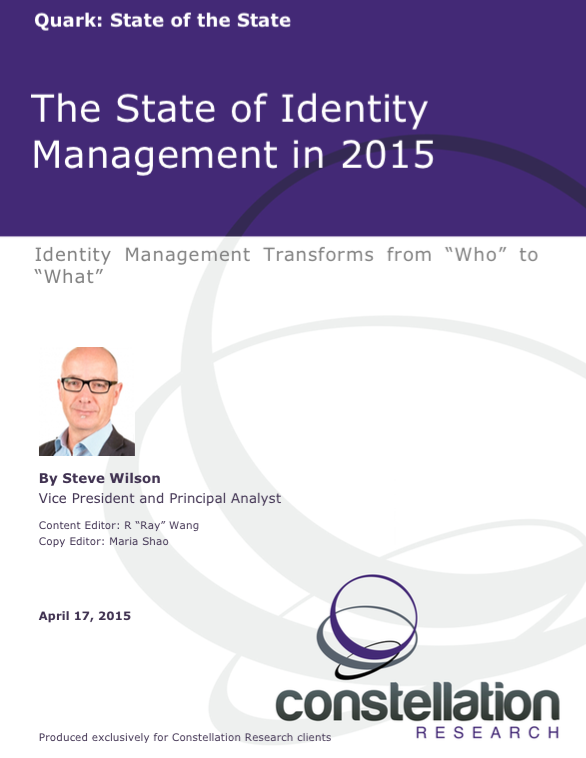 The State Of Identity Management in 2015
The State Of Identity Management in 2015
Constellation Research recently launched the "State of Enterprise Technology" series of research reports. These assess the current enterprise innovations which Constellation considers most crucial to digital transformation, and provide snapshots of the future usage and evolution of these technologies.
My second contribution to the state-of-the-state series is The State of Identity Management: Identity Management Moves from Who to What.
Here's an excerpt from the report:
Introduction
In spite of all the fuss, personal identity is not usually important in routine business. Most transactions are authorized according to someone's credentials, membership, role or other properties, rather than their personal details. Organizations actually deal with many people in a largely impersonal way. People don't often care who someone really is before conducting business with them. So in digital Identity Management (IdM), one should care less about who a party is than what they are, with respect to attributes that matter in the context we're in. This shift in focus is coming to dominate the identity landscape, for it simplifies a traditionally multi-disciplined problem set. Historically, the identity management community has made too much of identity!
Six Digital Identity Trends for 2015
1. Mobile becomes the center of gravity for identity. The mobile device brings convergence for a decade of progress in IdM. For two-factor authentication, the cell phone is its own second factor, protected against unauthorized use by PIN or biometric. Hardly anyone ever goes anywhere without their mobile - service providers can increasingly count on that without disenfranchising many customers. Best of all, the mobile device itself joins authentication to the app, intimately and seamlessly, in the transaction context of the moment. And today's phones have powerful embedded cryptographic processors and key stores for accurate mutual authentication, and mobile digital wallets, as Apple's Tim Cook highlighted at the recent White House Cyber Security Summit.
2. Hardware is the key - and holds the keys - to identity. Despite the lure of the cloud, hardware has re-emerged as pivotal in IdM. All really serious security and authentication takes place in secure dedicated hardware, such as SIM cards, ATMs, EMV cards, and the new Trusted Execution Environment mobile devices. Hardware security is intrinsically less flexible than software security (which is part of the point). However, today's leading authentication initiatives, like the FIDO Alliance, are intimately connected to standard cryptographic modules now embedded in most mobile devices. Hardware-based identity management has arrived just in the nick of time, on the eve of the Internet of Things.
3. The "Attributes Push" will shift how we think about identity. In the words of Andrew Nash, CEO of Confyrm Inc. (and previously the identity leader at PayPal and Google), "Attributes are at least as interesting as identities, if not more so." Attributes are to identity as genes are to organisms - they are really what matters about you when you're trying to access a service. By fractionating identity into attributes and focusing on what we really need to reveal about users, we can enhance privacy while automating more and more of our everyday transactions.
The Attributes Push may recast social logon. Until now, Facebook and Google have been widely tipped to become "Identity Providers", but even these giants have found federated identity easier said than done. A dark horse in the identity stakes - LinkedIn - may take the lead with its superior holdings in verified business attributes.
4. The identity agenda is narrowing. For 20 years, brands and organizations have obsessed about who someone is online. And even before we've solved the basics, we over-reached. We've seen entrepreneurs trying to monetize identity, and identity engineers trying to convince conservative institutions like banks that "Identity Provider" is a compelling new role in the digital ecosystem. Now at last, the IdM industry agenda is narrowing toward more achievable and more important goals - precise authentication instead of general identification.
5. A digital identity stack is emerging. The FIDO Alliance and others face a challenge in shifting and improving the words people use in this space. Words, of course, matter, as do visualizations. IdM has suffered for too long under loose and misleading metaphors. One of the most powerful abstractions in IT was the OSI networking stack. A comparable sort of stack may be emerging in IdM.
6. Continuity will shape the identity experience. Continuity will make or break the user experience as the lines blur between real world and virtual, and between the Internet of Computers and the Internet of Things. But at the same time, we need to preserve clear boundaries between our digital personae, or else privacy catastrophes await. "Continuous" (also referred to as "Ambient") Authentication is a hot new research area, striving to provide more useful and flexible signals about the instantaneous state of a user at any time. There is an explosion in devices now that can be tapped for Continuous Authentication signals, and by the same token, rich new apps in health, lifestyle and social domains, running on those very devices, that need seamless identity management.
A snapshot at my report "Identity Moves from Who to What" is available for download. It expands on the points above, and sets out recommendations for enterprises to adopt the latest identity management thinking.



